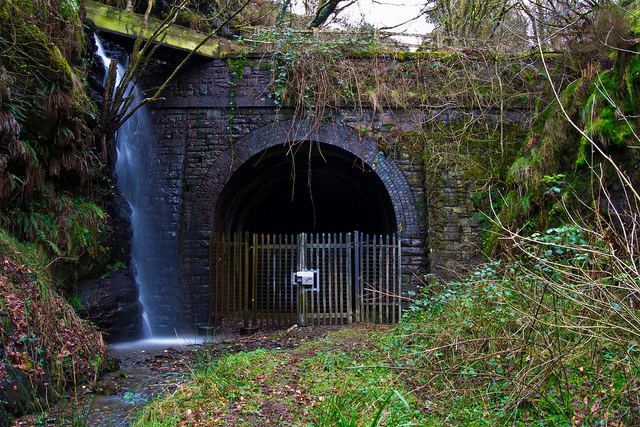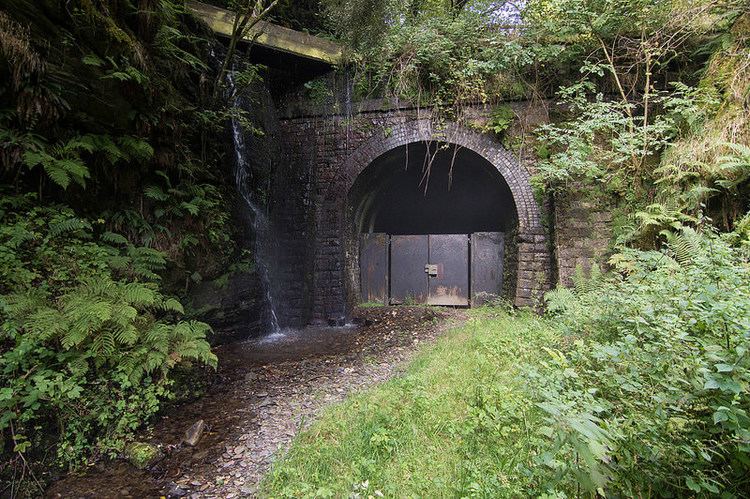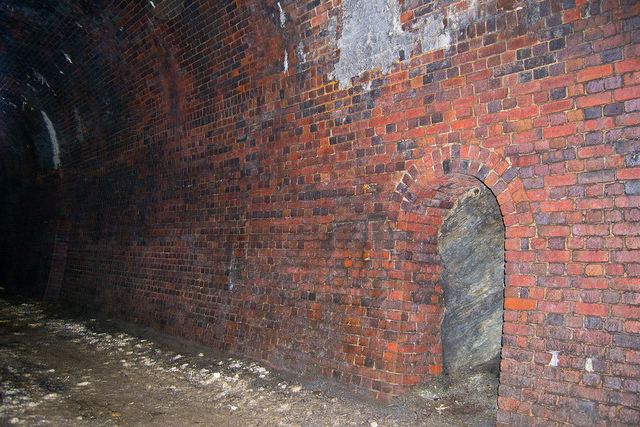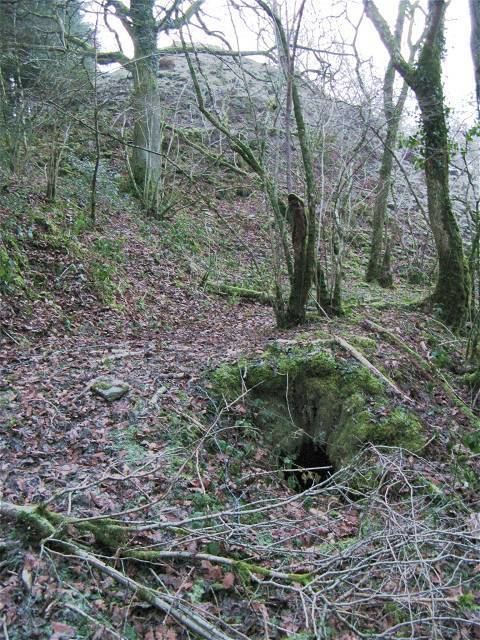 | ||
Pencader tunnel 30th april 2013
Pencader Tunnel is an abandoned railway tunnel on the old trackbed of the Carmarthen to Aberystwyth main line in south-west Wales. It was originally bored for the Llanpumsaint-Pencader section of the Carmarthen & Cardigan (C&C) Railway.
Contents

It is approximately 985 yards (901 m) long (just over half-a-mile), making it the longest tunnel in West Wales and is bored through Ordovician shales. It is single-track and built to the C&C's adopted broad gauge dimensions, as opposed to the smaller standard gauge used on Britain's railways today. It is also known as alternatively Alltwalis Tunnel and Dolgran Tunnel to local villagers.

History

From the first proposals of the Carmarthen and Cardigan railway it was known that an expensive and long tunnel would be needed to take the line between the valleys of Skanda Vale and Dolgran, under the Brechfa Forest watershed. Several separate Engineers surveyed the line, including Isambard Kingdom Brunel, with varying schemes. Brunel proposed a dead-straight tunnel to connect the valleys, though after reworking, the final design was longer in order to ease the gradients.

As built, the tunnel was approximately 985 yards (901 m) long, curving slightly from the southern portal in Skanda Vale, running straight for most of its length and then curving for the final third into Dolgran. The digging would require two construction shafts which could then be used for ventilation. Construction started in the spring of 1857 to bore the tunnel at the same time as work began on the first stage of the railway line in the town of Carmarthen.

During construction in 1859, the C&C railway attempted to switch from broad gauge to standard gauge, which would have meant all railway infrastructure (including the tunnel), could be built to smaller (and thus cheaper) dimensions. Such a change would require the approval of the British Parliament and pressurisation on the company by the South Wales Railway, a broad gauge line in the area which did not want the rival standard gauge making an incursion on its territory, meant the application to Parliament never occurred.

Digging initially proceeded from four sites - at either end and from the bottom of the first ventilation shaft sunk. Once the second shaft was finished, digging also commenced from there, though this had been abandoned by May 1860 according to a report which stated that 576 yards (527 m) had been dug by this time, approximately two-thirds of the full length. Work was expected to be finished by December 1860/January 1861.
As it stood, the tunnel was only 'finished' in March 1861 although, at the time, it was exposed rock without a brick lining and required further work to complete it. The long approach cuttings were also unfinished at this time. During construction of the tunnel, many of the horses used to haul away excavated rock died from disease and were buried in the field surrounding the northern of the two shafts. The same field also has grassed-over rubble remaining from cottages built by the construction navvies. Much of the spoil excavated was used to build embankments north and south of the tunnel but large spoil heaps can be seen on the hillsides around both ventilation shafts.
Further delays were caused by the original contractor for the railway, Jays of London, abandoning the construction of the line in autumn 1861. By November, however, another contractor, Holdens, had taken over the task. Work was focused on finishing several miles of railway either side of the tunnel and, although easy to the north, to the south, heavy engineering of cuttings and embankments slowed the work.
Track is known to have been laid through the tunnel at some point prior to December 1863, as a company report mentions an accident in that month on a ballast train en route to Pencader, beyond the tunnel. Official government inspection was carried out in January 1864 and the tunnel opened with the rest of the Llanpumsaint-Pencader section of the line on 1 April 1864. At the time, the tunnel was still unlined and a watchman was employed to inspect the tunnel for any rockfalls, until it was eventually lined with brick some years later.
By the time the tunnel was finished, having taken four years to build and a further three to complete the railway approaches to it, the project had crippled the finances of the Carmarthen to Cardigan Railway, which soon went into receivership. After the railway was closed to freight traffic on 28 September 1973, the track was removed. The tunnel was not demolished and remains in place.
Present state
The present state of the tunnel is accessible. Despite being bricked up at one point, both portals are now gated and the northern portal (51.9819°N 4.2994°W / 51.9819; -4.2994 (Pencader Tunnel, north portal)) and approach are privately owned and difficult to access due to a stream now occupying part of the trackbed. The south portal (51.9759°N 4.3058°W / 51.9759; -4.3058 (Pencader Tunnel, south portal)) is more accessible and has a small shed approximately 500 yards away, a former Permanent Way hut. Slightly further south are the foundations of the signal box for Pencader Tunnel Loop. The tunnel has two air shafts, located on the hillside above it. Both shafts are unlined and varying amounts of ground water drain through them into the tunnel. The north vent shaft was previously used for abseiling until maintenance work fixed a secure grating over it at the same time as the shaft's brickwork was re-pointed.
Walking through the tunnel can be difficult/dangerous due to deep mud at both ends - the majority of the tunnel is dry, however, as it lies on the summit of the line between Llanpumsaint and Pencader and thus any water seeping in drains away naturally. Both portals are muddy, the southern one more so due to a burst timber aqueduct over the portal and a small dam of earth that causes water and wet earth to back up behind it into the tunnel.
Further inside, the tunnel is in generally good condition due to being abandoned more recently than many disused tunnels and the brickwork remains in good condition except for a portion near the north portal where some has been dislodged.
There is a persistent local rumour that there is an escape-shaft from the tunnel in the form of a staircase cut into a side-shaft leading to the surface. Though such a shaft does not appear on surveys of the tunnel held by the British Railways Board, whose remnant, Rail Property Ltd is the current owner of the tunnel and responsible for its upkeep, recent explorations have confirmed its existence. It is unknown how far the passage continues and whether it exits into the ground above.
However, there's hope that one day "once the tunnel is stream free and officially accessible", the Gwili Railway could someday extend into Pencader, once a further a mile or two is required.
